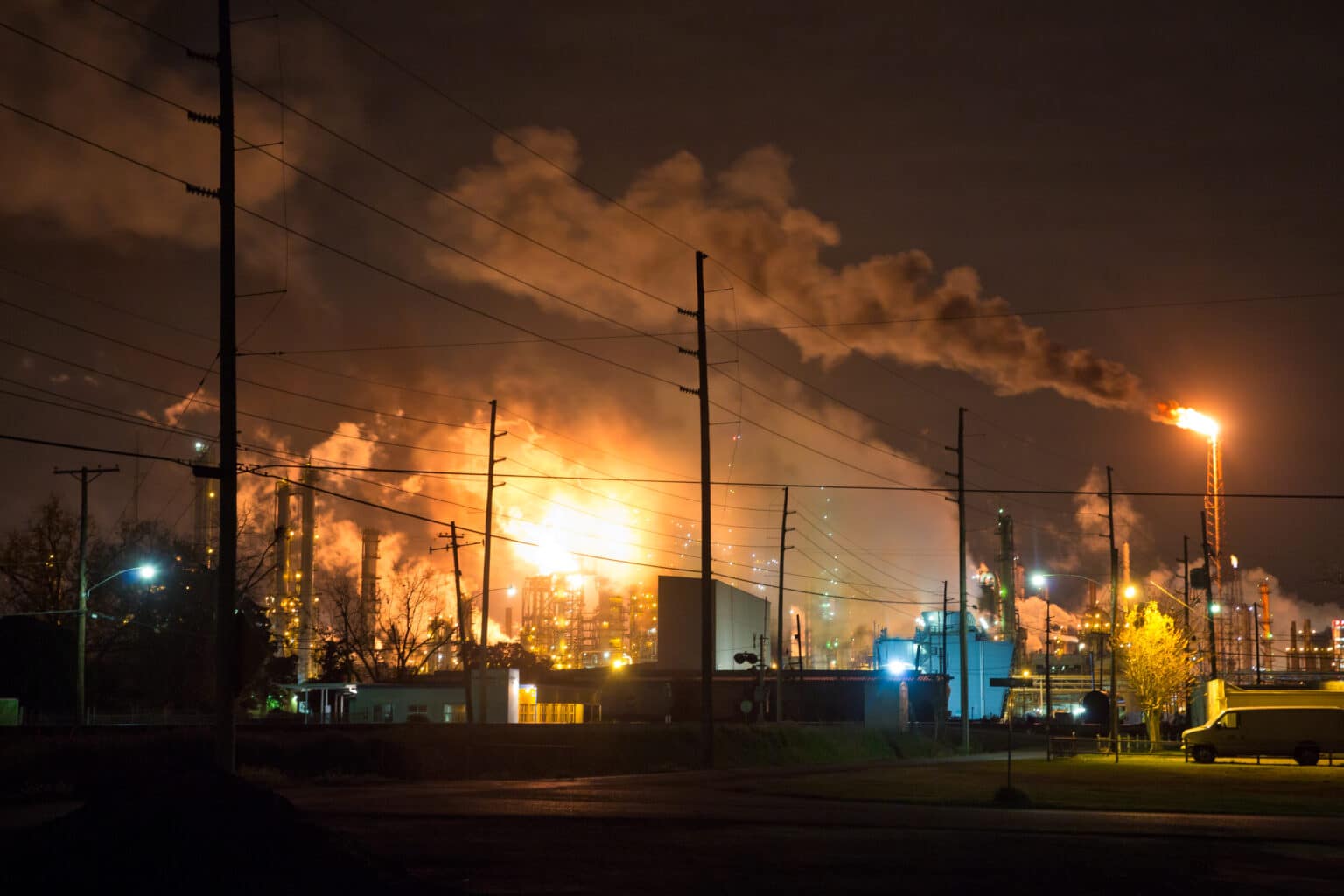More than a dozen U.S. oil refineries released the potent carcinogen benzene in 2020 at levels high enough to require action under federal law, the Environmental Integrity Project (EIP) reported this week. The report, which draws from government data, raises concerns about the potential health effects on those living near the refineries and the federal enforcement that the high levels of this cancer-causing air pollutant should trigger.
About 60 percent of the people living near the 13 refineries are people of color, EIP found, and residents living near refineries are several times more likely to have incomes below the poverty line than the U.S. average.
“These are exactly the places that got hurt the hardest by the pandemic,” said Eric Schaeffer, formerly director of civil enforcement at the U.S. Environmental Protection Agency (EPA) and now executive director of EIP, an environmental advocacy group. “These are exactly the places where people are already struggling with pre-existing health conditions that make them more vulnerable to pollutants like benzene.”
Louisiana is home to five of the refineries identified in EIP’s report, Texas to three, New Mexico two and one each in Alabama, Kentucky, and Pennsylvania.
Seven of the 13 refineries also reported similarly high levels in 2019, the report notes. 2019 was the first full year that the data was reported under 2015 EPA regulations requiring refineries to install benzene monitors at the outer edges of their plants.
“One of the reasons this matters so much is more than half a million people live within three miles of one of the 13 plants that have exceeded the action level,” said Schaeffer.
“More refineries exceeded the action level this year — 13 — than did at the end of 2019 when there were just 11,” Schaeffer added. “The data is supposed to drive action. It’s supposed to drive clean up. We’re asking EPA to step in and exercise its enforcement authority and get these numbers down, drive these numbers down at refineries where we already know they’re too high.”
An EPA spokesperson said that the agency would examine the recommendations in the report, adding that the benzene monitoring program has caused “a significant impact” on refinery emissions.
“EPA is committed to reducing benzene and other air toxic emissions from refineries and protecting those communities most at risk from air toxics,” an EPA spokesperson told DeSmog. “Throughout the development and implementation of the 2015 fenceline monitoring program, EPA has tracked the impact of these refineries on fenceline communities and has taken enforcement action to correct issues uncovered by the program.”
“Canary in a Coal Mine”
Benzene is perhaps one of the most commonly known carcinogens and can cause other health problems such as anemia and reduced immune response, according to the Centers for Disease Control and Prevention (CDC). The EPA also treats benzene as a “canary in a coal mine” for the presence of a broad array of other chemicals in the air around refineries, according to Schaeffer.
“If you see a high benzene number,” he said, “there are other refinery pollutants in the atmosphere that aren’t being measured but are also at elevated concentrations.”
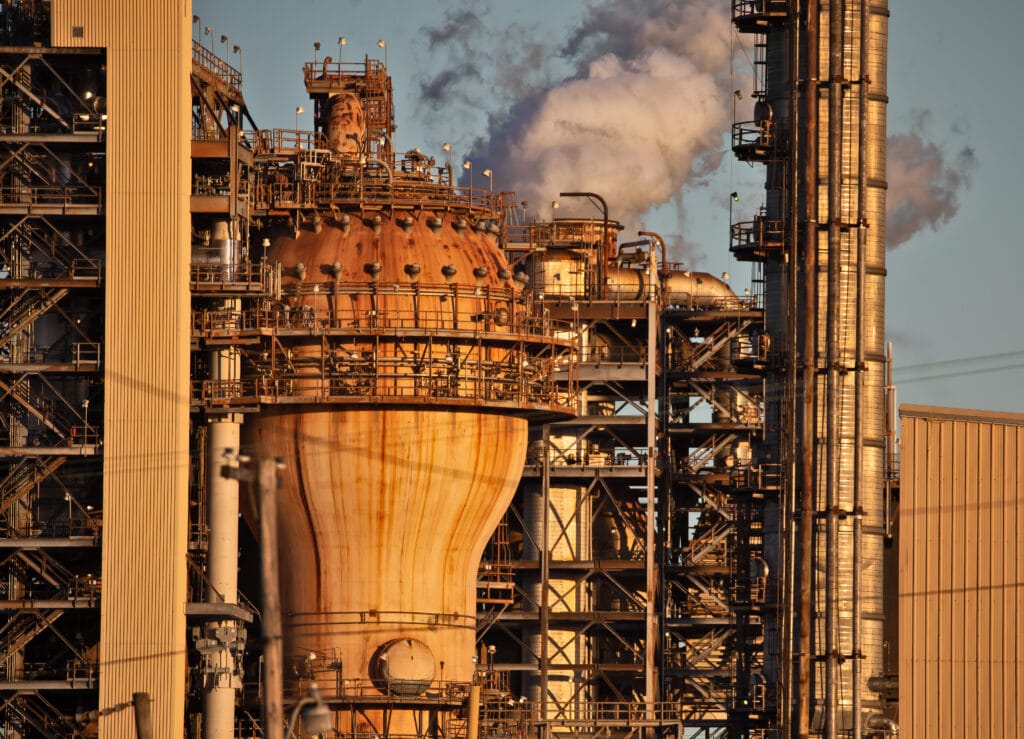
In a small handful of cases, the report found, benzene levels recorded in the air outside refineries averaged above 100 parts per billion (ppb) over a two-week period — the threshold where federal health officials say workers exposed to similar concentrations for less time should be issued respirators.
“People living near refineries are not necessarily exposed to the amount of benzene measured at the plant’s boundaries, as that may depend on wind direction, weather conditions, emissions from other sources, and other variables,” EIP wrote. “But when a refinery monitor reports that the average benzene level over two weeks is higher than the amount that workers should be exposed to for more than 10 hours without respirators, that should cause alarm.”
Previous research has shown that living near refineries is associated with higher rates of cancer. In December 2020, the Journal of the National Cancer Institute reported that cancer rates rose the closer people lived to refineries, based on an analysis of six different cancers affecting those over age 20 in Texas. In fact, out of the roughly 830,000 Texas cancer patients included in the study, researchers reported that over one third lived within a 30-mile radius of an oil refinery. Those living within 10 miles of a refinery, the researchers also reported, “had an increased risk of more advanced disease compared with persons residing 21-30 miles from an oil refinery.”
Benzene Spikes
The monitors outside refineries report data that’s averaged over a two-week period, making it possible to track not just continuous seeps of benzene from plants, but also the ways that individual spills and accidents — which can occur both inside and outside the refinery — affect the air along fence lines. In a few cases, the report points to spills or other incidents that may have occurred outside a refinery’s boundaries but were captured by the fenceline monitors.
The American Fuel and Petrochemical Manufacturers, a trade association representing U.S. oil refiners, did not immediately reply to a request for comment on the report’s findings from DeSmog.
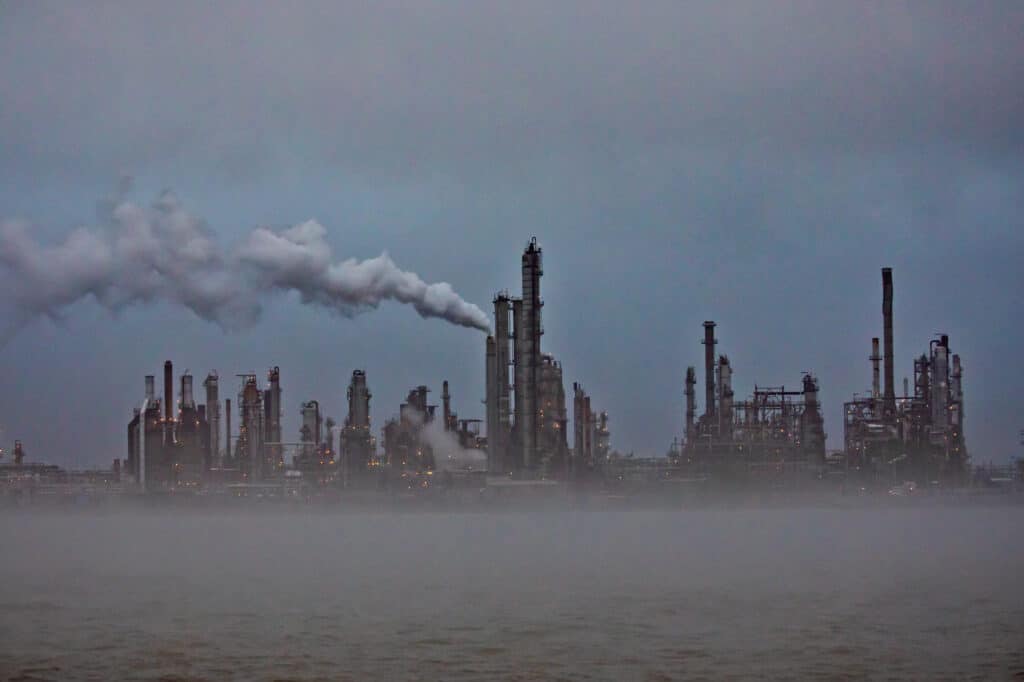
In some cases, particularly along the Gulf Coast, emissions events were linked to hurricanes and storms, EIP said. Not only can storms damage refinery equipment and cause leaks, but refineries often flare off excess fuel or chemicals to clear piping systems ahead of storms. For example, in the two days before Hurricane Laura, more than 4 million pounds of air pollutants including benzene were released by refineries, petrochemical plants, and other industrial sites, reported NPR.
“A lot of these facilities don’t have back up power,” said Ben Kunstman, one the authors of the EIP report. “For some of these hurricanes, there’s predictions weeks ahead of time that it could be hitting and these facilities have plenty of time to prep for those natural disasters, but a lot of the times what we see is that the refiner will continue to operate until the last possible minute and then shut down, which will cause a lot of these emission spikes.”
“So that makes it a little bit unpredictable,” Schaeffer said, “because things can be going pretty well and then half-way through the year you can get this mushroom cloud of benzene that drives your annual numbers up.”
The highest 2-week average benzene levels were outside the Valero Corpus Christi East plant in Texas, the report notes, whose neighbors are 87 percent people of color.
In some cases, benzene levels were already too high in 2019 — and then rose in 2020, EIP said, citing one refinery southeast of Houston. “Other plants, such as Marathon Galveston Bay or Total Port Arthur, show little apparent progress,” EIP wrote, citing emissions from those plants.
“This report is troubling,” John Beard, chairman of the Port Arthur Community Action Network, said in a statement released alongside the report, “and given that our city has twice the state and national average for cancer and respiratory diseases, serious enforcement action must be taken.”
Pollution Persists Near Shuttered Philadelphia Refinery
One of the 13 refineries identified in the EIP report was the Philadelphia Energy Solutions refinery, which was shut down in 2019 after a massive explosion and fireball shook the city of Philadelphia.
The former gasoline refinery’s annual benzene concentrations ranked second-highest of the plants listed in EIP’s report. Notably, it is also located in the most densely populated area, with over 300,000 people living within three miles of the plant. Over 60 percent are people of color, the report notes, and 45 percent have incomes that place them below the poverty line — about four times higher than the national average.
“High benzene concentrations have persisted at the former Philadelphia Energy Solutions (PES) refinery in Pennsylvania where annual benzene levels were more than three times higher than the action level more than a year after the plant closed,” EIP wrote. “The persistently high levels in densely-populated South Philadelphia are likely due to the ongoing removal of petrochemical products from the site.”
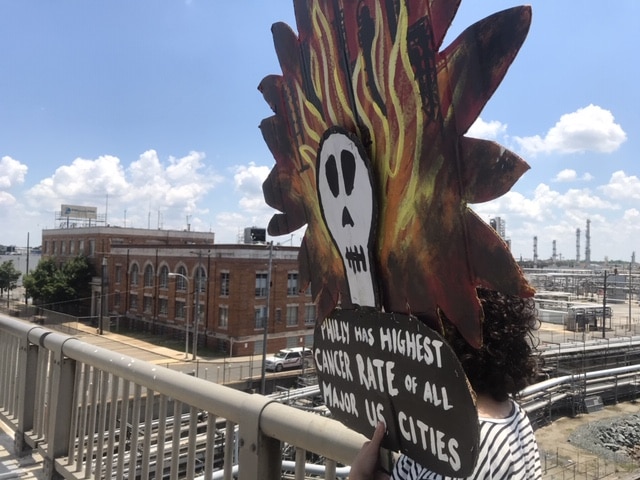
A spokesperson for Energy Transfer disputed those findings in an interview with the Philadelphia Inquirer. “We can’t speak to the report findings or the validity of the report since we haven’t seen it and don’t know how it was conducted, but I can tell you that their claim is false,” Lisa Coleman, a spokesperson with Energy Transfer told the newspaper. “Our site cleanup work would have no impact on the ambient air readings you are referring to.”
Local government officials have also disputed the notion that the benzene levels reported near the shuttered refinery could cause human health problems, citing lower readings from another monitor located in a residential neighborhood a short distance away from the refinery.
Residents living near the refinery have long reported serious health issues, even drawing national attention. “Gloria C. Endres, a lifelong resident, described the constant cough and runny nose as the ‘South Philly postnasal drip’ in a letter to The South Philly Review, a local publication. Derek Hixon joked that the South Philadelphia High basketball team ‘always has home-court advantage because opposing players find it hard to breathe,’” the New York Times Magazine reported last summer in a profile of the Grays Ferry neighborhood adjoining the PES refinery. “More ominous are the disturbingly frequent accounts of cancer.”
Appalachia’s Chemical Valley
Not all of the refineries that exceeded federal benzene action levels are in densely populated areas.
Dani Parent hails from Catlettsburg, Kentucky, a small town tucked along the Ohio River in the far eastern corner of the state. Today she lives a few miles upriver in Huntington, West Virginia, where she serves as communications co-coordinator for the Ohio Valley Environmental Coalition, an Appalachian environmental advocacy group.
“I grew up in a place called the Chemical Valley,” she said in a press call organized by EIP. “It is so named because of the concentration of chemical plants downriver from Charleston, West Virginia, to Catlettsburg, Kentucky. The trains going in and out of the refinery shook the windows of my childhood bedroom.”
Marathon Petroleum’s Catlettsburg refinery processes gasoline, asphalt, heavy fuel oil, propane, and more from sweet and sour crude, and it also processes condensate, prized by chemical manufacturers, from Utica shale wells. Twice in 2020, the EIP report found, the Catlettsburg refinery’s two-week average benzene levels were several times the level federal regulators consider acceptable for healthy adult workers.
“At the refinery last year, one-time events caused higher emissions readings, one of which caused the facility’s rolling annual average to exceed the EPA action level,” Marathon spokesman Jamal T. Kheiry told the Lexington Herald-Leader. “Other than those events — which we have since addressed — every two-week sampling period has been under the action level. At our Catlettsburg refinery, we continue to look for opportunities to reduce benzene emissions, as we do at all 13 of our petroleum refineries across the country.”
“Respiratory problems and cancer are the rule, not the exception,” Parent said as she described her childhood home, citing figures showing Catlettsburg’s residents are nearly twice as likely to experience a disability as the average American. “I come from people who are poor, sick, and who need their health and their bodies to work but are simultaneously forced to work in environments with hazardous conditions.”
Oil isn’t the only fossil fuel that’s played a major role in shaping Catlettsburg. The motto of Boyd County, whose county seat is Catlettsburg, is “Where Coal Meets Iron.” Nearly 20 million tons of coal were mined in Boyd County between 1838 and 1990, the last year the county saw active mining.
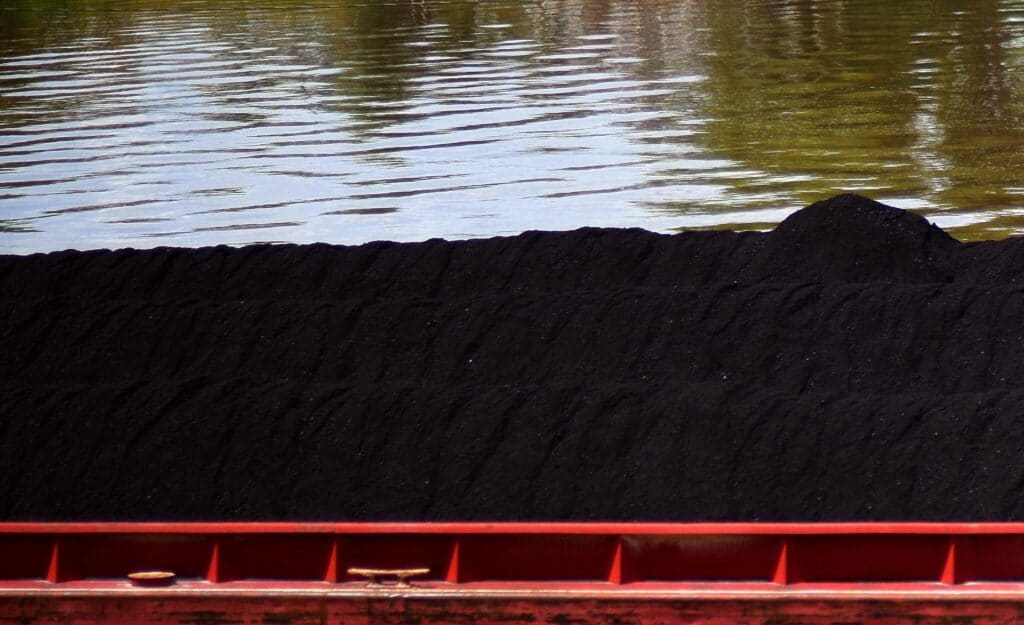
“The chemical industry moved in after the coal industry died out,” Parent said.
The area offered few career paths for those who wanted to stay — limited to either the hospital or the refinery, she continued. “Both of these are beloved and hated,” Parent said. “It’s also quietly acknowledged that their relationship is a symbiotic one.”
The result is that people in Catlettsburg don’t trust that the air they breathe or the water they drink is safe, according to Parent. “And they’re right not to trust because many times the air and water are toxic, as proved by this report, as they’re constantly reminded by the stacks on the horizon and multiple boil-water advisories in a month,” she said.
“I grew up in a place that deserves better, with people who deserve better,” Parent added. “And that begins with effective regulation and monitoring from the EPA.”
Subscribe to our newsletter
Stay up to date with DeSmog news and alerts


